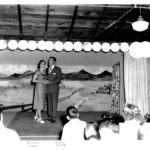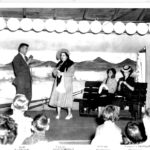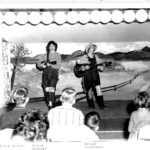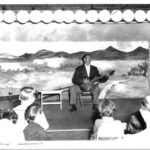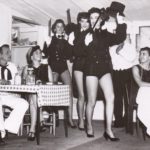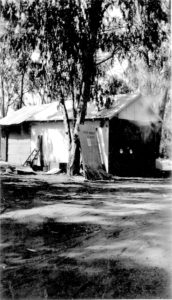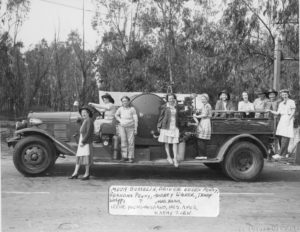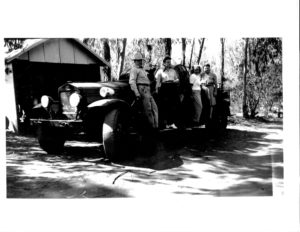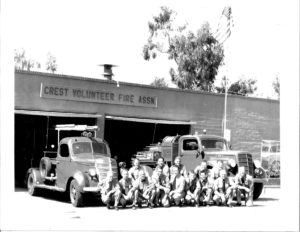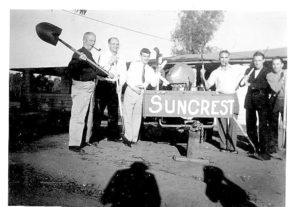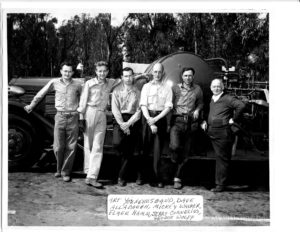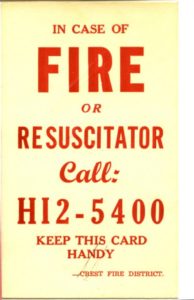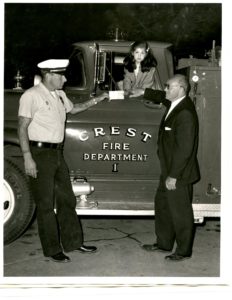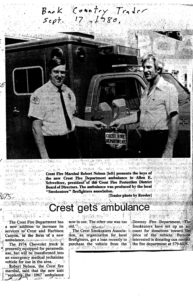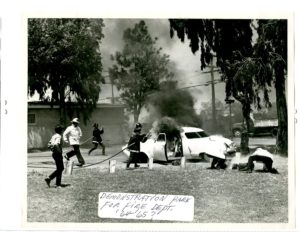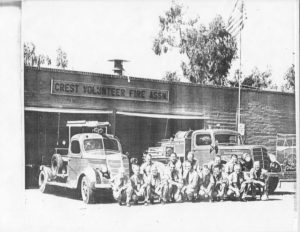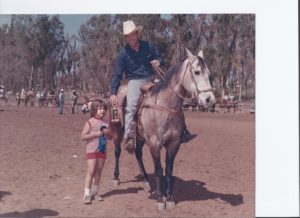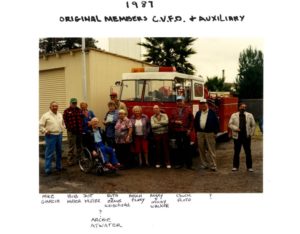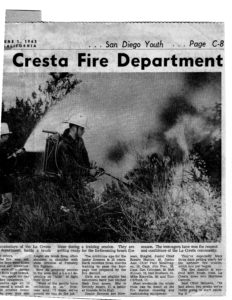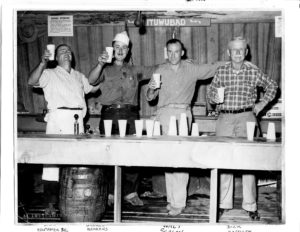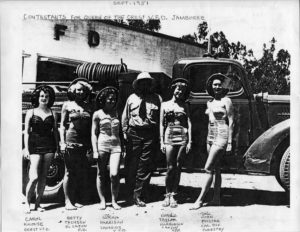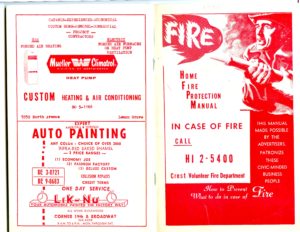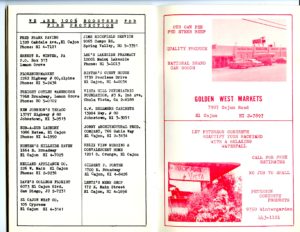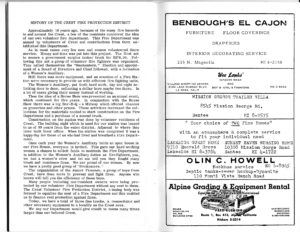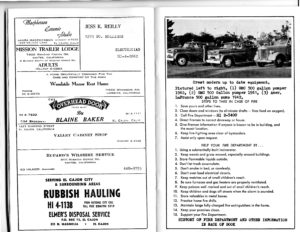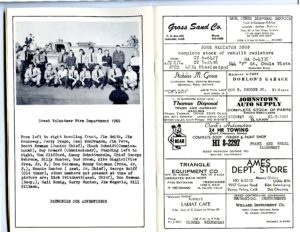Crest Volunteer Fire Department 1942-1951
Creation of the Crest Volunteer Fire Department– 1942-1951
The first firefighting equipment on the hill in 1942 consisted of barrels of water hauled on a trailer behind a private automobile. It was put together by members of Suncrest. This trailer was a car body frame from an old Ford. Oil drums were welded on to transport water. Equipment on this trailer consisted of three back pumps, one fireman’s ax, one brush hook, one McCloud rake, four buckets and three canteens. Volunteers who manned the trailer provided shovels. The trailer was attached to the vehicle that arrived first. It was parked to the left of the Suncrest Store. The volunteers were made up of retired men, local businessmen, high school students, or “whoever happened to be home that day.”
Because of the many fire hazards, a few of the residents conceived the idea of having a volunteer fire department. Finally, and largely due to prompting by the women of the community who often joined the men on the fire fighting lines, a volunteer fire department was organized in November 1945. This aroused the citizens of ”the hill” to purchase a small used pumper unit from government surplus for $276. That unit was eventually installed on an old Corbett crash truck purchased from North Island Naval Air Station. To buy this equipment, the whole hilltop worked together to raise money with barbeques and horse shows, dinners and dances, rummage sales, variety shows, and more.
On Labor Day weekend, September 1946, a brush fire occurred that burned 40 acres. In July 1947, there was a serious fire in Harbison Canyon which further motivated the community to move ahead with their fire protection efforts. A volunteer fire department was formed and in October 1947, it was chartered and the election and appointment of a Board of Directors and chief followed. Tom Jump was appointed the first fire chief. It was stated there were 40 members including a volunteer group called the “Smoke Eaters,” which was a social fundraising group. Twelve teen boys became very interested and involved, so the Junior Firemen was established. They did an outstanding job and many went on to make firefighting their career. Anyone who knows will tell you the efficiency of these boys.
The Ladies Auxiliary of the Crest Volunteer Fire Association 1947
At the same time, the Ladies Auxiliary of the Crest Volunteer Fire Association was formed, adopting their first set of bylaws in September 1947. The Crest Women’s Fire Auxiliary was not only very active socially, they also trained on the equipment and answered several calls when the men were not available. Their purpose was to operate equipment in the absence of men, assist with social affairs, and to obtain and furnish rations in emergencies. Their first efforts were cooking meals in the Suncrest Clubhouse for the men and the State Forestry who were working on the fire on the old Suncrest grade. First aid classes followed and more money was raised for equipment and a building fund. The Ladies Auxiliary put forth hard work, day and night soliciting door to door, collecting a dollar here and two there. During this era, women had duties such as grooming the American LaFrance Fire Truck and taking part in burn-offs; three of the women were licensed and qualified to drive the fire trucks. They were also trained for firefighting, and on various occasions used the equipment and were credited with saving at least two homes. They were the only insured group of firewomen in the country during that time. Girls over 14 could become part of the women’s group. The Ladies Auxiliary sponsored several groups of young people including the Junior Firegirls, the Crest Teeners Club, and the “Young-uns.”
Around 1947, the ladies began serious fundraising events to build a larger firehouse at Suncrest Blvd. and North Lane. Funds were raised by a series of dances and parties. On October 15, a dance raised enough money to exchange their manpower fire trailer for a truck.
Then the idea of a horse show was presented as an annual event, which continued for five years- from 1947 to 1951. In conjunction with the horse show there was a big barbeque and a midway as well as raffles which offered chances on groceries and other prizes. These “Crest Jamborees” helped provide the materials needed to start construction on the firehouse and the purchase of a second truck.
Crest Builds Its First Fire Station. Construction of the station was done by volunteer residents of Crest. The building site which is still used for our station was leased to the volunteer fire department for 99 years from the water district, adjacent to where they later built their office. The fire station remains in the same location to this day. When the station was completed, it was a happy day. This team effort of the residents brought “the hill” together as nothing else had ever done. Both the Crest Public Utility District and the Crest Volunteer Fire Department shared this site for many years.
On July 11, 1948 fire swept through the community of Suncrest. Flames shot as high as 75’ and 100’ at times during the advance on the Suncrest homes. The first firefighting unit on the scene was the Crest Volunteer Fire Department. Firemen, who battled the blaze as closely as they dared, often were forced to flee for their lives as the fire flared through thick dry brush. In the front ranks of the firefighters were the men, women and children who lived in the ridge top homes. Some families evacuated their children to El Cajon, but many boys and girls grabbed rakes, hoes, shovels, garden hoses, and wet gunny sacks to fight shoulder to shoulder with their parents. Housewives tore their aprons into strips, soaked them and wrapped them around their heads and necks to ward off the hot sparks showered by the flames in the brush. Miraculously, the 100 small homes in the rural community were spared.
At this time, many people including non-resident owners were being protected by the Volunteer Fire Department without any cost to them. The Crest Volunteer Fire Protection District, a taxing body, was formed to equalize the cost of a fire department and this enabled the community to finance real protection against fires.
The Volunteer Fire Department continued to be active in the 1950s. A fourth annual Jamboree was held in 1950 to support the purchase of two fire trucks and a fire station. More than 1500 community residents annually contributed material and labor for this event. In 1954, money was raised for the fire department by membership rather than rummage sales, dinners, and jamborees, to support the yearly budget of $2,223. The Women’s Fire Auxiliary continued to work hard to support the fire protection efforts through performances and other fund raising activities. From 1947 to 1951, the volunteer fire department held annual “Jamborees” lasting multiple days which brought as many as 2000 persons visiting the resort community. Events included a children’s field day held in Sunrise Park (South Lane Park), dances at the Suncrest Clubhouse, barbeques, and a horseshow. The event was sponsored to raise money for the volunteer fire department
The 1957 Crest Volunteer Fire Association recommended a tax be levied for the purpose of operating and maintaining a fire department. This was meant to equalize the burden of support to all property owners. It was stated that only 50% of the residents were contributing to the support of the fire department. The tax was not intended to require paid firemen, nor did it mean Crest fire protection would be taken over by any other agency. A taxable fire district was proposed so that the fire department could serve the needs of the community with a minimum budget on a sound financial basis.
Fires in the 50’s –
Fires in the 1950s were a big concern. The following fire information was retrieved from the Crest Historical Society archives:
June 28, 1950 – fire on the Jarrett property destroying a barn and moved up the north side of Lilac Drive. The fire was caused by children playing with matches. Crest volunteers kept the flames under control until five forestry service trucks arrived. Twenty five-houses were saved as they labored in the extreme heat of the midday. It was estimated that approximately 10 square blocks were razed.
July 1950 – 300 firemen and 18 trucks fought a fire lasting 24 hours. It was San Diego County’s second worst brush blaze sweeping 3,000 acres with 300 firemen and 18 trucks The wind carried flames up Rios Canyon to Oakridge and past the Crest, then swept out along the east side of Mountain View Road. It was thought that an unattended campfire might have started the fire.
June 1951 – More than 100 state, federal, and volunteer firefighters battled the 500 acre terrain south of Suncrest. Brush on the 1,900 foot hill just south of Suncrest was burned right down to the rock and boulders. An overnight field camp was set up at the edge of the still smoldering fire at the top of the old Suncrest south grade.
July 10, 1951 – A fire broke out near South Lane in Suncrest in the brush, near a well digging crew, and quickly spread over a 250 acre area. Two summer homes were lost at Suncrest. The flames burned out the brush between the area’s 100 homes. This Suncrest fire, which at one time threatened to be a major disaster, miraculously spared nearly all the homes. The firefighting crews had the fire practically under control in four hours. Firefighters from La Mesa, El Cajon, Crest and Harbison Canyon, Riverside, Valley Center, Elsinore, San Bernardino, Cuyamaca, Lyons Valley, Ramona, San Marcos, and the State Division of Forestry successfully fought the fire. Many sheds, small frame structures, and some telephone and power poles burned and crashed to the ground. An hour after the fire broke out, the underpinning on one of the community’s three large water tanks burned and the huge tank toppled to the ground. Forest Service tanker trucks were forced to go to the bottom of the west slope of the ridge for water. There was an estimated $25,000 in damages.
1965 – Volunteer Fireman Lt. Jack Dyer Dies While Protecting Crest From Wildfire
If you have driven through Crest, you most likely have seen the granite memorial stone in front of the Crest Fire Station. It is a dedication to Lt. Jack Dyer, a Crest volunteer fireman, and the volunteers that fought a deadly fire on October 21, 1965. John DaSilva, a volunteer fire fighter of only 13 at the time, shared the story of this particularly tragic event. On October 21, a fire traveled up Harbison Canyon. The volunteer fire department responded to the siren and rolled out to fight the fire. The fire was out of control due to high winds and the unavailability of borate bombers. Kids and adults alike fought the blaze into the night. In an effort to protect one of the homes, a change of wind sent the fire charging up the bank. Unfortunately, Lt. Dyer got caught in the flames. He was rushed to the hospital but died two weeks later.
. The major event of the 1970s was the Laguna Fire. Crest lost 118 homes. It certainly changed the life of the community residents. On September 26, 1970, fire broke out in the Kitchen Creek area of the Laguna Mountains. A strong Santa Ana was blowing eastward fanning flames from a fallen power line downhill through young timbers and burning wildly out of control within two hours. Roughly 36 hours later, the inferno had reached the Sweetwater Reservoir. By 5 o’clock the fire storm had roared up the canyon walls. Fanned by Santa Ana dry winds, the flames moved quickly eastward and northward roaring through the hills and canyons, eventually blackening over 175,000 acres and destroying over 380 homes in Crest and Harbison Canyon and more than 1,000 structures in San Diego County. Eight people lost their lives. Fire departments from all over Southern California had swarmed up the hill to converge upon the tiny mountain community, but nothing they did could stop the fire. Because of differing radio frequencies, there had been major problems with communications among the different units.
Crest Volunteer Fire Department Evolves – 1970 – 1990
During the 1970s, the chief was the only paid position in the volunteer fire department; his pay was minimal, making it a labor of love. The chief was the only member who attended the fire academy and trained the fire department volunteers. Gilbert Mastri wrote, “I learned to be a volunteer firefighter and would train each Thursday night. I would volunteer during the days since I worked nights. There were about 30 volunteers in all, including many juniors who were high school kids volunteering after school. The station was manned during the day when they would maintain equipment. If there was an emergency, there was a special call number and they would set off the siren and everyone would come running to assist with the fire or medical event.”
The district had a small working budget available through county funds but they relied heavily on grant writing and fundraisers to purchase needed equipment and other necessities. In 1976, the budget for the Crest Volunteer Fire Department was $95,088. The 1979 budget was $112,528.
The men’s Smoke Eaters group and Women’s Fire Auxiliary worked to raise money for the department. Some of Gilbert’s fondest memories of Crest were participating in the Smoke Eaters events. “We would help elderly people that needed weed abatement, put on Mother’s Day pancake breakfasts, have cookouts, and other organizational parties. It was a very active and rewarding group.” What ever happened to the Smoke Eaters? As time went on, federal and state grants/programs became available allowing the fire department to start hiring full-time fire fighters, starting with typically one paid man per shift. Eventually, Crest merged with the Bostonia Fire Department in the 1990s to create the East County Fire Protection District. At that point, there wasn’t as great a need for volunteers or fundraising. Eventually, the Smoke Eaters organization slowly died off.
On April 8, 1980, a special election was held and a “Special Benefit Tax for Fire Suppression and Emergency Services” initiative was passed by two-thirds of the voters. The $40 tax was to fund operating expenses, capital improvement expenditures and debt repayment. In 1984, the Crest Fire Protection District budget was $159,640. Slowly the volunteer positions were being replaced by paid positions. The fire chief in 1983-1984 was paid $16,80.0. In the 1980s the Crest Volunteer Fire had a trained 25 member organization plus junior fire patrol, equipped with a fire station housing three trucks including a modern pumper plus an ambulance rescue unit.
In 1983, the benefit fee was not sitting well with portions of the community. They circulated petitions und Prop N to have the tax repealed.
On July 1, 1994, the Bostonia and Crest Fire Protection Districts were consolidated into the East County Fire Protection District. After analyzing the budget, it became apparent that without additional revenue, the budget could not be balanced with current staffing levels. This would later lead to the demise of the East County Fire Protection District.
2002 -Crest Passes Paramedic Special Benefit Tax
A special benefit tax for the “Provision of Advanced Life Support/Engines Paramedic Firefighter” was approved within the entire boundary of the East County Fire Protection District at the general election held November 5, 2002. The measure received 71.5% voter support. The purpose of the tax was to provide paramedic/firefighters to ensure advanced life support service on the Crest hill..
October 26, 2003 – The Cedar Fire Devastates Crest
Once again, disaster struck the Crest community. The Cedar Fire, a human-caused wildfire driven by Santa Ana winds, resulted in the largest fire recorded in California history. In San Diego County, some 280,000 acres burned, 15 people died, and 2,232 homes were lost. The Crest statistics were grim. Of Crest’s 1,100 plus homes, 290 homes were lostm including the Crest Clubhouse. There were 327 displaced families. Twenty-seven families were uninsured and many more were underinsured.
Crest Fire Safe Council established in 2003
In the months and years following the Cedar Fire, the community sought solutions to prevent another catastrophic event. The Crest Fire Safe Council (CFSC) was established by Noelle Carranza, Debbie Milligan-Fox, Kathleen Fiedor, and Kandhy Franklin-Collins. Under the diligent leadership and guidance of Kandhy, efforts continued to find solutions to future fire threats. Surveys were conducted, town hall meetings held, and break-out groups were formed. Solutions included:
- The implementation of a community-wide emergency call system. Also an email notification system was established.
- The installation of a fire siren behind the Crest Community Association building to provide a better warning system.
- The securing of a USDA Forest Service grant of $208,000 in 2008 to be used for education outreach, training sessions and, most importantly, fuel reduction. CFSC contracted with Environmental Land Management which brought hand crews, machinery, and several hundred goats to Crest to provide fuel reduction in strategic areas of the community.
- Educating the community about preparing for emergencies, creating defensible space around homes, evacuation routes, and emergency shelter locations.
East County Fire Protection District in Trouble – 2007
As the East County Fire Protection District transformed from a volunteer fire department to a paid district, the fire board soon found that our local fire department could not sustain itself without an adequate tax base. Writing grants alone could not support the station. By 2007, the East County Fire Protection District (ECFPD) found itself in dire budgetary straits. ECFPD approached nearby districts looking to consolidate, but no one was interested in taking over a fire district that could not support itself. With the district running “in the red,” the department approached the Crest residents and asked them to consider a special tax to raise additional revenue to fund operating expenses for the local fire department. This would allow the district to maintain its current levels of service. Without the passage of Proposition E, the fire department doors would close and we would no longer have a fire department on the hill. Proposition E ensured the Crest community would continue to receive fire and medical emergency services. While the tax was a widely controversial issue and the subject of more than one town hall meeting, Proposition E passed on September 25, 2007 with 73.2% support.
What the community did not realize was the passage of this tax would open the doors for a different set of issues. All of a sudden agencies were interested in taking over our district for its revenue, but not necessarily ones that the Board of Directors wanted to be aligned with. The board felt they needed to join forces with a district that would serve Crest’s best interests. Consequently, in July of 2008, they negotiated a merger with the San Miguel Fire Protection District. This, again, proved to be very controversial in that it was the elected fire board’s responsibility to make the decision and residents did not get to vote on this decision. The board’s vote to consolidate ended local control. This was a decision that many residents did not agree with.
In 2013, San Miguel Fire District began having budgetary problems. The San Miguel Fire District Board entered into a Cooperative Agreement with CAL FIRE. As a result, our firefighters shifted employment from the district to the State (CAL FIRE) with San Miguel still in control of the budget, buildings, and equipment.
In spite of all the controversy, Crest still welcomes our paramedics and fire protection on the hill. Our local firefighters are still involved with the community. Their presence is welcomed as they escort Santa to the annual CCA Christmas party and continue to lead our yearly Crest July 4th parade. Our fire department will always play an important role in our community.

